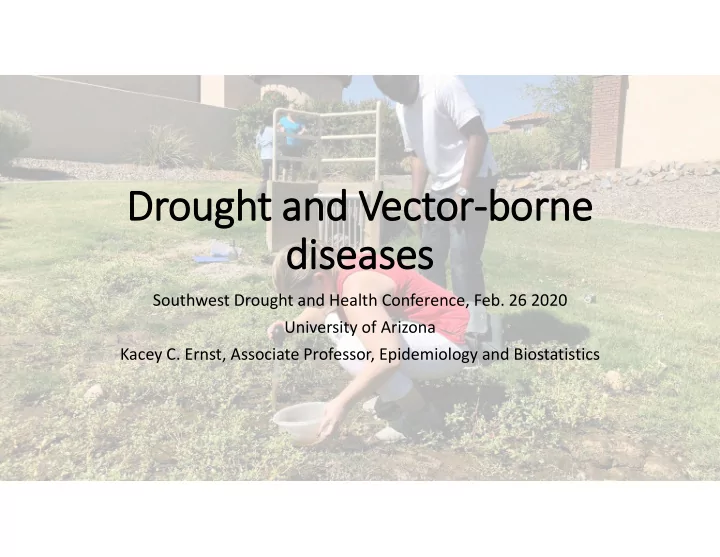

Dr Drought and Vector or-bo borne ne di disea eases Southwest Drought and Health Conference, Feb. 26 2020 University of Arizona Kacey C. Ernst, Associate Professor, Epidemiology and Biostatistics
Po Potential fo for tr transmission Reproductive number for mosquito-borne diseases (modification of the vectorial capacity equation) m: ratio of mosquitoes to humans a: mosquito biting rate (on humans) b and c: pathogen transmission efficiencies (human to mosquito and mosquito to human) p: daily survival rate of mosquitoes r: the recovery rate in humans (i.e., the reciprocal of the infective period of the human host) n: the duration of the extrinsic incubation period (EIP).
Other potential vectors of regional interest Triatome (kissing bug): Brown Dog Tick: Rocky Fleas: Plague disease * Chagas disease $ Mountain Spotted Fever* * Transmission documented in Arizona $ One case study of possible local transmission
Mosquito life-cycle
Oviposition sites Precipitation Driven Anthropogenic water sources
Flower pot saucers – number one suspect
Co-benefits and inadvertant consequences- water management • Drought – water storage – dengue fever • The case of Australia, Honduras, Brazil Beebe NW et. al.(2009) PLoS NTD 3(5).
Drought – West Nile virus • Factors contributing to WNV activity vary by region Paull S. et. al., Proc. R. Soc. B, 2017
More than just mosquito abundance West Nile Virus and Drought Grackel House sparrow House finch Paul S, et. al, PRSB 2017; Johnson BJ et.al., JME 2013; Shaman et.al. JME 2005;
Drought and feeding behavior • Dehydration • Increased biting frequency • Lab only comparison between biting rates of Culex at high temperature in low and high humidity Hagan et. al. Dehydration prompts increased activity and blood-feeding by mosquitoes Scientific Reports, (2018)
Rocky Mountain Spotted Fever and the Brown Dog Tick • Resistant to dessication • Compared to other tick species (e.g. Lone Star Ticks) • BDT has an extremely hard cuticle that helps protect it from desiccation • Can “drink from the air" by excreting a hydrophilic solution from its salivary glands • May seek peridomestic environments when not on host to avoid dry air
Plague • Recent evidence suggests – prairie dogs more susceptible to fleas during drought (Eads et. al., Journal of Mammology, 2016) • Plague activity in Europe is synchronous with drought between 1300-1800. (Yue et.al. STE, 2020)
Triatome and Chagas • Some indication of shifting habitats during dry periods • Little known about our specific species • Not thought to be very competent vector
Summary • Dynamics between vector-borne diseases and drought are complex and relate to: • Host immunity • Immature and adult habitat preferences • Ability to survive desiccation • Changes to feeding habits • Ecology of each vector-pathogen-host(s) dynamic is needed • However, evidence suggests increasing frequency of droughts may drive higher VBD risk parameters
Recommend
More recommend